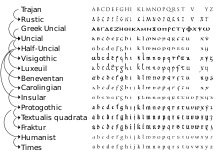This is the current revision of this page, as edited by SpringProof (talk | contribs) at 14:38, 22 November 2024 (Cleaned up using AutoEd). The present address (URL) is a permanent link to this version.
Revision as of 14:38, 22 November 2024 by SpringProof (talk | contribs) (Cleaned up using AutoEd)(diff) ← Previous revision | Latest revision (diff) | Newer revision → (diff) Form of the letter g used in Insular fonts in the Old English alphabet| This article includes a list of references, related reading, or external links, but its sources remain unclear because it lacks inline citations. Please help improve this article by introducing more precise citations. (September 2016) (Learn how and when to remove this message) |



Insular G (majuscule: Ᵹ, minuscule: ᵹ) is a form of the letter g somewhat resembling an ezh, used in the medieval insular script of Great Britain and Ireland. It was first used in the Roman Empire in Roman cursive, then it appeared in Irish half uncial (insular) script, and after it had passed into Old English, it developed into the Middle English letter yogh (Ȝ ȝ). Middle English, having reborrowed the familiar Carolingian g from the Continent, began to use the two forms of g as separate letters.
Letter

The lowercase insular g (ᵹ) was used in Irish linguistics as a phonetic character for [ɣ], and on this basis is encoded in the Phonetic Extensions block of Unicode 4.1 (March 2005) as U+1D79. Its capital (Ᵹ) was introduced in Unicode 5.1 (April 2008) at U+A77D. The insular g is one of several insular letters encoded into Unicode. Few fonts will display all of the symbols, but some will display the lowercase insular g (ᵹ) and the tironian et (⁊). Two fonts that support the other characters are Junicode and Tehuti.

| Insular letters in Unicode | ||||||||||||||||
| 0 | 1 | 2 | 3 | 4 | 5 | 6 | 7 | 8 | 9 | A | B | C | D | E | F | |
| U+1ACx | ◌ᫌ | ◌ᫍ | ◌ᫎ | |||||||||||||
| U+1D7x | ᵹ | |||||||||||||||
| U+1DDx | ◌ᷘ | |||||||||||||||
| U+204x | ⁊ | |||||||||||||||
| U+2E5x | ⹒ | |||||||||||||||
| U+A77x | Ꝺ | ꝺ | Ꝼ | ꝼ | Ᵹ | Ꝿ | ꝿ | |||||||||
| U+A78x | Ꞃ | ꞃ | Ꞅ | ꞅ | Ꞇ | ꞇ | ||||||||||
| U+A7Dx | Ꟑ | ꟑ | ||||||||||||||
Notes
| ||||||||||||||||
The insular form of g is still used in traditional Gaelic script.
Turned insular g
A turned version of insular g (Ꝿ ꝿ) was used by William Pryce to designate the velar nasal ŋ.
See also
References
- Everson, Michael (2006-08-06). "L2/06-266: Proposal to add Latin letters and a Greek symbol to the UCS" (PDF).
External links
- Drawing an insular G (here mistaken for yogh)
- Michael Everson's article On the derivation of YOGH and EZH shows insular g in several typefaces.
| Latin script | |||||||||||||||||||||||||||||||||||||||||||||||||||||
|---|---|---|---|---|---|---|---|---|---|---|---|---|---|---|---|---|---|---|---|---|---|---|---|---|---|---|---|---|---|---|---|---|---|---|---|---|---|---|---|---|---|---|---|---|---|---|---|---|---|---|---|---|---|
| Alphabets (list) | |||||||||||||||||||||||||||||||||||||||||||||||||||||
| Letters (list) |
| ||||||||||||||||||||||||||||||||||||||||||||||||||||
| Multigraphs |
| ||||||||||||||||||||||||||||||||||||||||||||||||||||
| Keyboard layouts (list) | |||||||||||||||||||||||||||||||||||||||||||||||||||||
| Historical Standards | |||||||||||||||||||||||||||||||||||||||||||||||||||||
| Current Standards | |||||||||||||||||||||||||||||||||||||||||||||||||||||
| Lists | |||||||||||||||||||||||||||||||||||||||||||||||||||||
This article related to the Latin script is a stub. You can help Misplaced Pages by expanding it. |
This phonetics article is a stub. You can help Misplaced Pages by expanding it. |